|
Athens Athens, the capital of Greece, was once a small village at the foot of the ancient Acropolis (a fortified city built on a hill or rock) on the plain of Attica in south eastern Greece. |
|
The Parthenon (Gr: parthenos = virgin) was built during the 5th century B.C. in the ‘Golden Age of Pericles’ when Athens was at the height of its glory. It was a temple dedicated to the honour of Athena Parthenes, the (virgin) patroness of Athens, whose highly ornate 12 metre high statue was erected in an inner chamber. The building was a perfectly proportioned sculpture constructed to house the goddess, rather than a place of worship as one normally thinks a temple to be. The architects Ictinus and Callicrates worked under the chief designer, the sculptor Phidias. This temple of Athena was situated on top of a limestone crag (the Acropolis) overlooking the ancient city. It dominated the skyline as it does even today, despite its present less than perfect appearance, and provided a spiritual focus for the people of Athens. The Parthenon has also been a Christian church, a Muslim mosque and an ordnance depot. Its current state of ruin is largely the result of a 1687 Venetian bombardment of occupying Turks, who had stored gunpowder within it. Much of the original frieze (part of the ‘Elgin Marbles’) was removed by the British Lord Elgin in the early 19th century and subsequently acquired by the British Museum; other parts are found in museums in Paris, Athens and the Vatican. It is the largest Doric temple ever built, and is constructed entirely without mortar and cement. |
|
Rules of temple design Some of the rules for temple design found in the Parthenon are: (i) The building was placed with its sides facing the four points of the compass, with the main entrance at the eastern end. Christian cathedrals are still placed this way. (ii) The temple was built as an Octastyle structure, i.e., it has 8 columns at each end and 2
|
(iii) The diameter of the column base is the fundamental unit which fixes the proportions of the building. Thus, • the ratio of column spacing to the column base diameter is 9:4. • the ratio temple width : column height = 9:4. • the ratio of the height of the columns to the column base diameter is 5.48:1 (Why?) • the ratio of the column base diameter to the height of the frieze is 9:4 and so on. (iv) Greek temple architects observed that columns in the form of slightly tapered cylinders appear from a distance to curve inwards, creating the illusion of being narrow waisted. So they designed the columns with a slight outward bulge, with the result that the sides look straight. (v) The golden section, can be found in much of the building’s proportions, although it is not known if it was used deliberately. |
|
As with the columns, the base of the temple was made to curve slightly upwards in the middle along each of its four sides to make it look straight. This was the method used. LetAB denote the side-length of the Parthenon, and let M bisect AB (right). Let the maximum height HM of the base above AB be 100 mm (close to the actual value). Now divide AM (and similarly MB) into 5 equal parts. Dividing the height (100) by the square (25) of the number of parts (5) gives a working unit of 4 mm. Now working left from M, the height of the base above each of the equal subdivisions is taken to be 100, 100 – 22 = 96, 100 – 42 = 84, 100 – 62 = 64, 100 – 82 = 36, and 100 – 102 = 0. In practice, the heights were formed by using levelling blocks of thicknesses 4 mm, 3
|
||||
|
The hyperbola of the echinus
The second Greek order of architecture involves a curve which was suggested by the growth of the ram’s horn. This curve could well have been an equiangular spiral, which may be found as a natural growth spiral in shells, sunflowers and the horns of many animals.
|
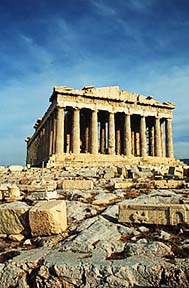

 Today modern Athens has a population of over 3 000 000, and is a city of concrete and mostly narrow, congested streets. In summer, when most tourists visit, the city is very hot, dusty, crowded, and polluted with exhaust fumes; yet it is a place not to be missed. The tourist attractions are the museums, including the National Archæological Museum, the restaurants, the old shopping area known as the Plaka, the ancient monuments, and above all (literally), the Acropolis, which incorporates arguably ‘the most perfect building ever created’, the Parthenon.
Today modern Athens has a population of over 3 000 000, and is a city of concrete and mostly narrow, congested streets. In summer, when most tourists visit, the city is very hot, dusty, crowded, and polluted with exhaust fumes; yet it is a place not to be missed. The tourist attractions are the museums, including the National Archæological Museum, the restaurants, the old shopping area known as the Plaka, the ancient monuments, and above all (literally), the Acropolis, which incorporates arguably ‘the most perfect building ever created’, the Parthenon.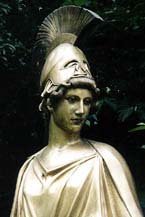 The Parthenon
The Parthenon
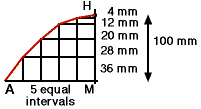 The curvature of the base
The curvature of the base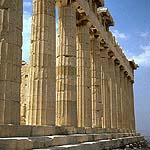
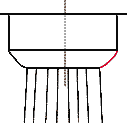 The parabola was not the only conic (section of a cone) used in the design of the Parthenon. For precision, all reproducible parts were made from known curves. In the basic Doric style of architecture, the curved boundary of the cross-section of the stone capping on top of the fluted column (called the echinus) was a section of a hyperbola.
The parabola was not the only conic (section of a cone) used in the design of the Parthenon. For precision, all reproducible parts were made from known curves. In the basic Doric style of architecture, the curved boundary of the cross-section of the stone capping on top of the fluted column (called the echinus) was a section of a hyperbola.